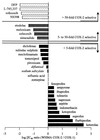Nonsteroid drug selectivities for cyclo-oxygenase-1 rather than cyclo-oxygenase-2 are associated with human gastrointestinal toxicity: a full in vitro analysis - PubMed (original) (raw)
Nonsteroid drug selectivities for cyclo-oxygenase-1 rather than cyclo-oxygenase-2 are associated with human gastrointestinal toxicity: a full in vitro analysis
T D Warner et al. Proc Natl Acad Sci U S A. 1999.
Erratum in
- Proc Natl Acad Sci U S A 1999 Aug 17;96(17):9666
Abstract
The beneficial actions of nonsteroid anti-inflammatory drugs (NSAID) can be associated with inhibition of cyclo-oxygenase (COX)-2 whereas their harmful side effects are associated with inhibition of COX-1. Here we report data from two related assay systems, the human whole blood assay and a modified human whole blood assay (using human A549 cells as a source of COX-2). This assay we refer to as the William Harvey Modified Assay. Our aim was to make meaningful comparisons of both classical NSAIDs and newer COX-2-selective compounds. These comparisons of the actions of >40 NSAIDs and novel COX-2-selective agents, including celecoxib, rofecoxib and diisopropyl fluorophosphate, demonstrate a distribution of compound selectivities toward COX-1 that aligns with the risk of serious gastrointestinal complications. In conclusion, this full in vitro analysis of COX-1/2 selectivities in human tissues clearly supports the theory that inhibition of COX-1 underlies the gastrointestinal toxicity of NSAIDs in man.
Figures
Figure 1
The effects of celecoxib (A), diclofenac (B), etodolac (C), ibuprofen (D), meloxicam (E), and nimesulide (F) on the activity of COX-1 (solid line), WBA-COX-2 (short dashed line), and WHMA-COX-2 (long dashed line). Results are expressed as percent of control and are represented as mean ± SEM. (n = 5–8).
Figure 2
The effects of diisopropyl fluorophosphate (A), L-745,337 (B), NS398 (C), and rofecoxib (D) on the activity of COX-1 (solid line), WBA-COX-2 (short dashed line), and WHMA-COX-2 (long dashed line). Results are expressed as percent of control and are represented as mean ± SEM. (n = 5–8).
Figure 3
Determinable log [IC80 ratio (WBA-COX-2/COX-1)] for all agents assayed (see Table 1). The “0 line” indicates equipotency, i.e., an IC80 ratio of 1. Italics indicate compounds with very low potency.
Figure 4
Analysis of the percent inhibition of COX-1 seen when COX-2 (WHMA) is inhibited by 80%. The dotted line indicates equiactivity, i.e., an 80% inhibition of COX-1.
Similar articles
- Gastrointestinal toxicity of non-steroidal anti-inflammatory drugs: the effect of nimesulide compared with naproxen on the human gastrointestinal tract.
Bjarnason I, Thjodleifsson B. Bjarnason I, et al. Rheumatology (Oxford). 1999 May;38 Suppl 1:24-32. doi: 10.1093/rheumatology/38.suppl_1.24. Rheumatology (Oxford). 1999. PMID: 10369403 Review. - Cyclooxygenase-2 inhibitors: a new class of anti-inflammatory agents that spare the gastrointestinal tract.
Masferrer JL, Isakson PC, Seibert K. Masferrer JL, et al. Gastroenterol Clin North Am. 1996 Jun;25(2):363-72. doi: 10.1016/s0889-8553(05)70252-1. Gastroenterol Clin North Am. 1996. PMID: 9229578 Review. - Biochemical and pharmacological profile of a tetrasubstituted furanone as a highly selective COX-2 inhibitor.
Riendeau D, Percival MD, Boyce S, Brideau C, Charleson S, Cromlish W, Ethier D, Evans J, Falgueyret JP, Ford-Hutchinson AW, Gordon R, Greig G, Gresser M, Guay J, Kargman S, Léger S, Mancini JA, O'Neill G, Ouellet M, Rodger IW, Thérien M, Wang Z, Webb JK, Wong E, Chan CC, et al. Riendeau D, et al. Br J Pharmacol. 1997 May;121(1):105-17. doi: 10.1038/sj.bjp.0701076. Br J Pharmacol. 1997. PMID: 9146894 Free PMC article. - [New NSAIDS: COX-1, COX-2, what about them?].
Peretz A. Peretz A. Rev Med Brux. 1998 Sep;19(4):A399-402. Rev Med Brux. 1998. PMID: 9805982 Review. French. - Selective cyclo-oxygenase-2 inhibitors: cardiovascular and gastrointestinal toxicity.
Wallace JL, Muscará MN. Wallace JL, et al. Dig Liver Dis. 2001 Dec;33 Suppl 2:S21-8. doi: 10.1016/s1590-8658(01)80155-9. Dig Liver Dis. 2001. PMID: 11827359 Review.
Cited by
- Reduction in cancer risk by selective and nonselective cyclooxygenase-2 (COX-2) inhibitors.
Harris RE, Beebe J, Alshafie GA. Harris RE, et al. J Exp Pharmacol. 2012 Aug 10;4:91-6. doi: 10.2147/JEP.S23826. eCollection 2012. J Exp Pharmacol. 2012. PMID: 27186121 Free PMC article. Review. - Prediction of the potency of mammalian cyclooxygenase inhibitors with ensemble proteochemometric modeling.
Cortes-Ciriano I, Murrell DS, van Westen GJ, Bender A, Malliavin TE. Cortes-Ciriano I, et al. J Cheminform. 2015 Jan 16;7:1. doi: 10.1186/s13321-014-0049-z. eCollection 2015. J Cheminform. 2015. PMID: 25705261 Free PMC article. - Indomethacin-induced translocation of bacteria across enteric epithelia is reactive oxygen species-dependent and reduced by vitamin C.
Schoultz I, McKay CM, Graepel R, Phan VC, Wang A, Söderholm J, McKay DM. Schoultz I, et al. Am J Physiol Gastrointest Liver Physiol. 2012 Sep 1;303(5):G536-45. doi: 10.1152/ajpgi.00125.2012. Epub 2012 Jun 14. Am J Physiol Gastrointest Liver Physiol. 2012. PMID: 22700821 Free PMC article. - Role of cyclooxygenases 1 and 2 in the modulation of neuromuscular functions in the distal colon of humans and mice.
Fornai M, Blandizzi C, Colucci R, Antonioli L, Bernardini N, Segnani C, Baragatti B, Barogi S, Berti P, Spisni R, Del Tacca M. Fornai M, et al. Gut. 2005 May;54(5):608-16. doi: 10.1136/gut.2004.053322. Gut. 2005. PMID: 15831902 Free PMC article. - Role of COX-2 in cough reflex sensitivity to inhaled capsaicin in patients with sinobronchial syndrome.
Ishiura Y, Fujimura M, Yamamoto H, Ohkura N, Myou S. Ishiura Y, et al. Cough. 2010 Aug 9;6:7. doi: 10.1186/1745-9974-6-7. Cough. 2010. PMID: 20696045 Free PMC article.
References
- Vane J R. Nat New Biol. 1971;231:232–239. - PubMed
- Vane J R, Bakhle Y S, Botting R M. Annu Rev Pharmacol Toxicol. 1998;38:97–120. - PubMed
- Patrignani P, Panara M R, Greco A, Fusco O, Natoli C, Iacobelli S, Cipollone F, Ganci A, Créminon, Maclouf J, et al. J Pharmacol Exp Ther. 1994;271:1705–1712. - PubMed
- Brideau C, Kargman S, Liu S, Dallob A L, Ehrich E W, Rodger I W, Chan C-C. Inflamm Res. 1996;45:68–74. - PubMed
Publication types
MeSH terms
Substances
LinkOut - more resources
Full Text Sources
Other Literature Sources
Chemical Information
Molecular Biology Databases
Research Materials



